The Bushman's Buttocks: A Lesson to be Learned!
Pictured below you see a side view of a Kalahari Bushman, and of a western man
with a "Swayback". There are a number of postural and muscular comparisons to make.
The key one that I wish to point out is the massive (!!!!!)
difference in gluteal musculature between the Bushman and the western man.
| The Bushman.. Note his large buttocks. |
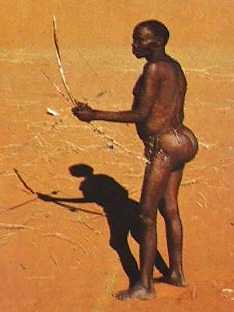 |
The western man, note his diminutive(!!!) buttocks.
(Also Note: Approximately 40% of western males adopt the "swayback" posture portrayed in this
picture). |
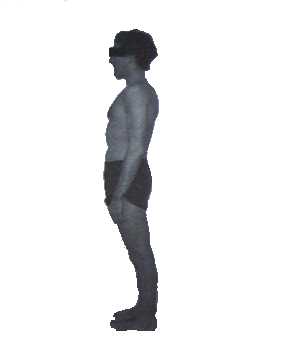 |
This is not just some ivory
tower academic observation! The Westerner's Gluteals are woefully underdeveloped,
with drastic consequences in terms of pain and poor function in the following locations:-
- The lumbar spine and sacral region.
- The hip region.
- The lower leg.
If you have pain in any of these locations, then this article will benefit you!

Article Summary:
With the help of this article, you will
observe or experience:-
- The difference in gluteal development between western man
and "primitive" man, (what do I mean by "primitive"?)
- An analysis of photographic evidence relating gluteal development to
"barefoot" walking and running.
- The demonstration in your own body of two major ways in which posture and movement
differ between modern western man and "primitive man". Involves:-
- removing your shoes and walking/running.
- latrine squatting.
- A short review of evidence regarding the increase in back
pain in recent western society.
- A description of the anatomical connection of the gluteus maximus to the
lower back via the thoraco-lumbar fascia.
- A set of basic Gluteus maximus work outs that demonstrate that "engaging Gluteus maximus" is a
valid method of limiting extremes of lumbar spinal movement, and thereby avoiding
back damage and back pain.
gluteus maximus work outs.
- Physiotherapeutic text book evidence that "engaging
Gluteus maximus" helps prevent painful conditions of, and around, the hip joint.
- Information regarding walking barefoot as a means to treating
and preventing repetitive stress ailments of the foot and lower leg.
You don't need to do rigorous Gluteus maximus work outs -Just engage
Gluteus maximus as you walk, run and sit!
|
Reasons for the Difference...
Firstly, I acknowledge that there is a genetic component to the Bushman's gluteals.
(Refer: "Steatopygia"
also "Social & Clinical Comments" .
But it is the behavioural component of "Bushman's gluteals" that I wish emphasize here.
After all, we cannot change our genes, but we can change our behaviour!
The large gluteals in the bushman are due to two identifiable causes
- Bare-foot walking
- Routine squatting while at work.
Both of these will be discussed with special emphasis on the lessons that can be
learned about modern western musculo-skeletal health.
You don't need to do rigorous Gluteus maximus work outs -Just engage
Gluteus maximus as you walk, run and sit!
|
1. Bare-foot Walking
The bushman wears no shoes during his daily routine, while western man wears
very comfortable shoes, and has done so ever since modern plastics replaced old
fashioned and unyielding shoe leather. Evidence that bare-foot walking and running
develops the gluteals will now be presented.
Take a look at the picture of Zola Budd-Pieterse
during her embarrassing 3,000 meter race at the 1984 Los Angeles Olympics. She
was booed home in the event after American favourite Mary Decker tripped on
Budd's heel and fell. A tearful Budd finished seventh in this, her debut Olympic
event. At that time, she was a victim of vehement Anti-Apartheid demonstration.
She was later to became 5,000 meter world record holder.
Zola is running bare foot. The very first thing we notice about Zola is that
she has an extremely wiry build even for an endurance athlete.
|
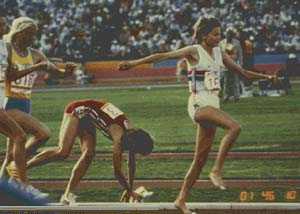
A Traumatic Moment: Zola Budd and Mary Decker at the 1984 Los Angeles Olympics |
But note also
Zola's relative lack of hamstring development when compared with the unfortunate
Mary Decker, who is falling to the ground. Note also that Zola's buttock (gluteal)
region is the one
anatomical part of her that is well developed when compared to her more amply
built competitors. This one picture, though not perfect, gives graphic evidence
that bare foot running develops the gluteal musculature, while comfortable footed
running develops the hamstrings.
| Now check out the old-fashioned footwear and
muscular development of this more stoutly built Finnish athlete:- He has none-padded
running shoes, "poorly" developed hamstrings, and an obviously
well filled out gluteal. He is not running bare foot, but his hard bottomed shoes
are not pampering him either. This picture gives evidence that hard shoeing,
and not just bare-footedness promotes gluteal development over hamstring development.
You have now seen the photographic evidence that bare-footedness is associated
with gluteal development. The following exercises give you the opportunity to
experience the bushman style of walking that develops those impressive gluteal muscles. |
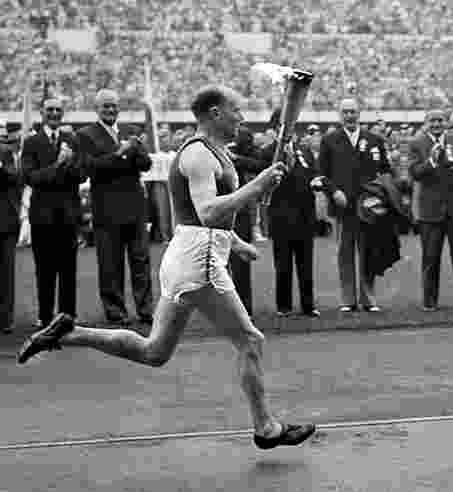
Finnish Olympian:- Note the hard old fashioned running shoes and the
well developed gluteal muscles.
|
The Barefoot Walking Exercise:-
(Learning to engage Gluteus Maximus at heel strike).
This learning exercise is worth getting right. It taught me to regain
pain free hip movement, and it can teach you similar things.
Find a rough road surface, preferably with loose stones on it (for safety's sake, and also
for modesty, make it a quiet stretch of road!).
|
Before we start, you need to know just where the Gluteus maximus is:-
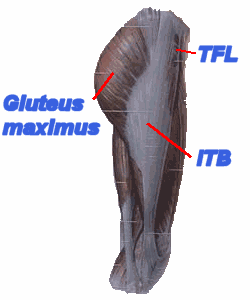
|
And you need to know how to tell if it is engaging: just place the fingers over the sit bone
as per diagram below (don't do this while someone is watching!):-
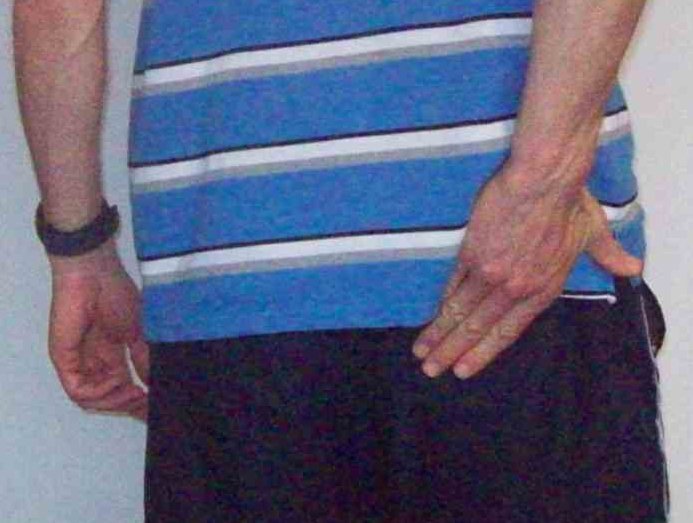 |
(1) Walk with your shoes on and in a sway back posture:
Adopt a "swayback" posture (see diagram) by locking your
knees and leaning slightly backwards. Now place your fingers over your gluteus
maximus, and start walking. The gluteus will tend not to engage upon heel strike as it
should. (Don't make a habit of this style of walking. I did, and it caused me
a lot of pain).
|
 |
| (2) Now walk with your shoes on in your normal posture:
Place your fingers over your gluteus maximus, and start walking.
Note whether the gluteus engages upon heel strike. Your gluteus may or may not
engage. If it does, that's good, your habitual posture is not "swayed back" as in
the diagram to the right:- |
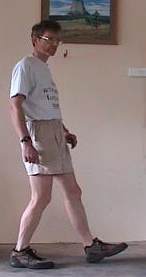 |
| (3) Now walk with your shoes off: (For the sake of this exercise, it is best
to do it on sharp, painful stones - The more painful the better!)
Place your fingers over your gluteus maximus, and start walking. Note whether
the gluteus tenses upon heel strike. (If the surface is painful enough, the
gluteus will indeed engage- and very strongly so too). Congratulations!
You have now discovered
the basic walking pattern of the bushman! His buttocks prove that barefoot walking/engaging
Gluteus maximus is better than any Gluteus maximus work outs. |
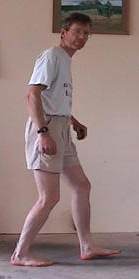 |
(4) Now put your comfortable shoes back on:
Practice walking by engaging gluteus maximus at heel strike. Note what happens
to your posture and the way your foot lands. By engaging Gluteus maximus at heel
strike, you will (to some extent) be walking as though you were bare foot.
Keep walking and running with gluteus maximus engaging at heel strike, and you
too may develop those amazing bushman "glutes"- (assuming you want that of course!).
Seriously though, you will be minimizing the risk of a multitude of repetitive stress
injuries.
Now just to round off the
lesson:
Whether you walk bare-foot on rough stones, or whether you strongly engage Gluteus
maximus at heel strike, the same things happen to your body positioning:-
- Torso leans slightly forwards, especially at the moment of heel-strike.
- Hips joints flex slightly at heel-strike.
- Knees flex slightly at heel-strike i.e. they are not prone to locking.
- Knee caps tend to point outward as opposed to "squinting" inwards i.e. hip
medial rotation is avoided.
- Ankle flexes slightly at "heel-strike".
- Foot loading at "heel strike" is shared evenly between heel and toe: means that the heel
does not take the total impact, and the ankle flexor muscles (muscles at the front
of the shin) are not having to work hard to support the heel and keep the toes up
at the moment of heel-strike.
- Foot arch tending to form and lift the instep off the ground.
At the moment of shock loading when the foot lands, many joints are positioned
closer to their mid-range of movement. According to OBP theory
(Definition and in depth discussion....), this mid
range of movement at the moment of "heel-strike"
lets the muscles adopt their optimum length to absorb and handle shock loading.
Just a few of the multiple benefits of bare-foot-walking/engaged Gluteus
maximus will be discussed further, but before that we need to rediscover the other
major movement pattern of the Gluteus maximus.
|

You don't need to do rigorous Gluteus maximus work outs -Just engage
Gluteus maximus as you walk, run and sit!
|
2. The Latrine Squat
The following quote is from Physiotherapist
Wayne Milicich(2):-
"Back pain is rare in the cultures of Africa and Asia where they do not use the
western chair. They squat flat-footed. It is not the chair that is creating
the problem, but our lack of utilizing natural movement patterns such as the
Flat-footed Squat in other situations".(2)
"Latrine squatting" is the second movement pattern that the bushman routinely
adopts but which the westerner does not.
See next Exercise!
The "Latrine Squat":-
(Working the Gluteus maximus over its longer range)
|
- Place your fingers over the Gluteus maximus.(Not shown in picture).
- Lower yourself toward the ground, keeping your torso and tibias more or less
parallel to each other.
- Note when your gluteals are engaging.
- Maintain slight tension in the Glute', and try squatting for a minute or more!
Comments:-
- The latrine squat gets the Gluteus maximus to do work over its longer range,
and at its full extent (when you are fully squatting), gives it a "stretch".
- You may not be able
to lower yourself all the way, and that is OK. There is an alternative exercise to
latrine squatting- see "Rest Position" in the EasyVigour Pilates library.
- You may find it a help if you place a one inch board under your heels.
- What feels strange to you is in fact very normal and natural to the "Primitive"
(See picture). So don't be put off. If he can do it, you can do it! Squatting is one of the
essential gluteus maximus work outs!
|
 |
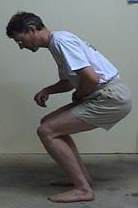
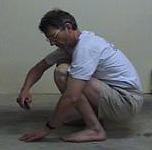
|

|

You don't need to do rigorous Gluteus maximus work outs -Just engage
Gluteus maximus as you walk, run and sit!
|
Benefits
of a Functional Gluteus Maximus:-
The Evidence.
(Note: This section is somewhat technical. So you may choose to ignore it or
skim through quickly).
Let's just recap what we have learned so far:-
We know that "primitive" man has large buttocks, whereas western man has
comparatively atrophied buttocks.
We have performed a couple of gluteus maximus work outs that prove that Bare-foot walking
increases Gluteal muscle activity.
We have performed the latrine squat, and again experienced the Gluteus maximus in
action, but this time working through a longer (more stretched) range.
These simple differences in habitual usage patterns of the gluteals have huge significance:
The knowledge that I have on this subject
has helped me to regain pain free movement. I want to share that knowledge with you!
Six pages Follow:-
- Gluteus maximus in the role of back stabilizer
- Gluteus maximus in the role of hip joint stabilizer
- Gluteus maximus in the role of lower leg "positional optimizer"
- The Gluteus maximus - "Social & Clinical
Discussion"; Gluteus maximus - "Steatopygia"
- Gluteus maximus Success Story: - Pain Free
Bare Foot Running in 3 Months
- Gluteus maximus, Cure for Piriformis Syndrome



Return to top...
Engage Gluteus maximus!
© Bruce Thomson, EasyVigour Project

|
|
Film Footage of Bushman Walking and Running!
Two classic low budget comedies from the 80's.
The first disc has a documentary feature on the real life of star
N!xau who played Xixo.
"If you're willing to laugh at
yourself, pick these up!"
(Mark Baker, Amazon.com review)
|
|